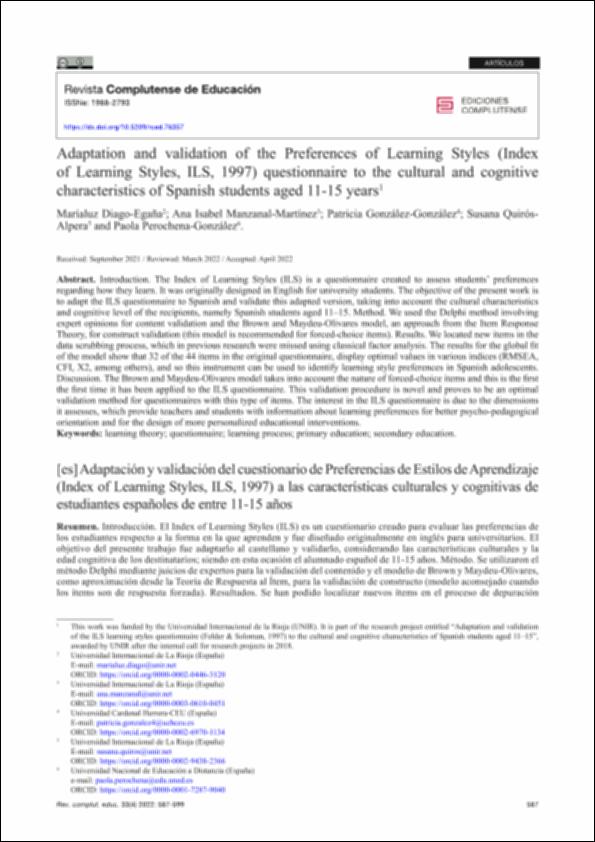Por favor, use este identificador para citar o enlazar este ítem:
http://hdl.handle.net/10637/14439Adaptation and validation of the Preferences of Learning Styles (Index of Learning Styles, ILS, 1997) questionnaire to the cultural and cognitive characteristics of Spanish students aged 11-15 years
| Título : | Adaptation and validation of the Preferences of Learning Styles (Index of Learning Styles, ILS, 1997) questionnaire to the cultural and cognitive characteristics of Spanish students aged 11-15 years |
| Otros títulos: | Adaptación y validación del cuestionario de Preferencias de Estilos de Aprendizaje (Index of Learning Styles, ILS, 1997) a las características culturales y cognitivas de estudiantes españoles de entre 11-15 años |
| Autor : | Diago Egaña, María Luz Manzanal Martínez, Ana Isabel González González, Patricia Quirós Alpera, Susana Perochena González, Paola |
| Materias: | Estudiantes de enseñanza secundaria - Aprendizaje.; High school students - Knowledge and learning.; Learning.; School children - Knowledge and learning.; Niños - Aprendizaje.; Estudiantes de enseñanza primaria - Aprendizaje. |
| Editorial : | Universidad Complutense de Madrid, Facultad de Educación |
| Citación : | Diago-Egaña M., Manzanal-Martínez A. I., González-González P., Quirós-Alpera S. y Perochena-González P. (2022). Adaptación y validación del cuestionario de Preferencias de Estilos de Aprendizaje (Index of Learning Styles, ILS, 1997) a las características culturales y cognitivas de estudiantes españoles de entre 11-15 años. Revista Complutense de Educación, vol. 33, n. 4 (25 may.), pp. 587-599. DOI: https://doi.org/10.5209/rced.76357 |
| Resumen : | Introduction. The Index of Learning Styles (ILS) is a questionnaire created to assess students’ preferences regarding how they learn. It was originally designed in English for university students. The objective of the present work is to adapt the ILS questionnaire to Spanish and validate this adapted version, taking into account the cultural characteristics and cognitive level of the recipients, namely Spanish students aged 11–15. Method. We used the Delphi method involving expert opinions for content validation and the Brown and Maydeu-Olivares model, an approach from the Item Response Theory, for construct validation (this model is recommended for forced-choice items). Results. We located new items in the data scrubbing process, which in previous research were missed using classical factor analysis. The results for the global fit of the model show that 32 of the 44 items in the original questionnaire, display optimal values in various indices (RMSEA, CFI, X2, among others), and so this instrument can be used to identify learning style preferences in Spanish adolescents. Discussion. The Brown and Maydeu-Olivares model takes into account the nature of forced-choice items and this is the first the first time it has been applied to the ILS questionnaire. This validation procedure is novel and proves to be an optimal validation method for questionnaires with this type of items. The interest in the ILS questionnaire is due to the dimensions it assesses, which provide teachers and students with information about learning preferences for better psycho-pedagogical orientation and for the design of more personalized educational interventions. Introducción. El Index of Learning Styles (ILS) es un cuestionario creado para evaluar las preferencias de los estudiantes respecto a la forma en la que aprenden y fue diseñado originalmente en inglés para universitarios. El objetivo del presente trabajo fue adaptarlo al castellano y validarlo, considerando las características culturales y la edad cognitiva de los destinatarios; siendo en esta ocasión el alumnado español de 11-15 años. Método. Se utilizaron el método Delphi mediante juicios de expertos para la validación del contenido y el modelo de Brown y Maydeu-Olivares, como aproximación desde la Teoría de Respuesta al Ítem, para la validación de constructo (modelo aconsejado cuando los ítems son de respuesta forzada). Resultados. Se han podido localizar nuevos ítems en el proceso de depuración que, en investigaciones anteriores, se escapaban con el análisis factorial clásico. El ajuste global del modelo demuestra que 32 ítems, de los 44 en el cuestionario original, muestran valores óptimos en diversos índices (RMSEA, CFI, X2, entre otros) por lo que este instrumento puede ser aplicado para identificar las preferencias de estilos de aprendizaje en adolescentes españoles. Discusión. El modelo de Brown y Maydeu-Olivares tiene en cuenta la naturaleza de los ítems de respuesta forzada y es la primera vez que se aplica al cuestionario ILS. Este procedimiento de validación resulta novedoso y demuestra ser un método óptimo de validación de instrumentos con este tipo de ítems. El interés por el cuestionario ILS se debe a las dimensiones que evalúa, que aportan información al profesor y al estudiante sobre las preferencias de aprendizaje para realizar una mejor orientación psicopedagógica y para el diseño de intervenciones educativas más personalizadas. |
| Descripción : | Este artículo se encuentra disponible en la siguiente URL: https://revistas.ucm.es/index.php/RCED/article/view/76357/4564456561027 |
| URI : | http://hdl.handle.net/10637/14439 |
| Derechos: | http://creativecommons.org/licenses/by/4.0/deed.es |
| ISSN : | 1130-2496 1988-2793 (Electrónico) |
| Idioma: | es |
| Fecha de publicación : | 25-may-2022 |
| Centro : | Universidad Cardenal Herrera-CEU |
| Aparece en las colecciones: | Dpto. Ciencias Biomédicas |
Los ítems de DSpace están protegidos por copyright, con todos los derechos reservados, a menos que se indique lo contrario.


